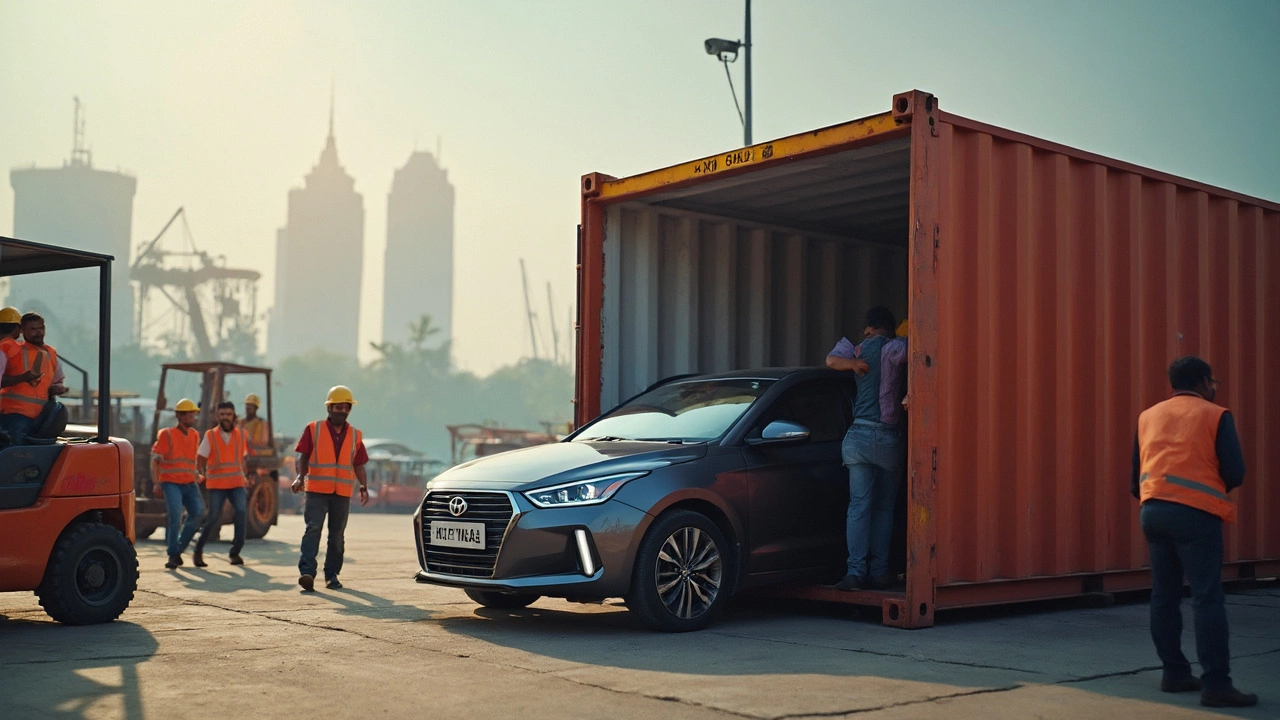Can I Import a Car from India to the USA? Insider Tips and the Real Challenges

Bringing a car from India to the US sounds cool—maybe you’re into unique models or just want a fresh ride that stands out in the parking lot. But there’s a huge difference between wishing for your Tata Nano in LA and actually getting it off a US port. Rules here aren’t just strict—they’re relentless. Between customs forms, safety inspections, and cough-inducing emission tests, you’ll find out fast whether it’s worth the hassle.
First things first, the US doesn’t play around with car imports. Don’t expect to just ship the car, show up, and cruise out. Every vehicle must meet Department of Transportation (DOT) and Environmental Protection Agency (EPA) standards, which are honestly much tougher than anything you’ll find in India. Most Indian cars aren’t built with these in mind, so you’ll either have to make some upgrades or look for an exception—and both take cash.
- Why Import a Car from India?
- US Import Regulations: The Big Roadblocks
- The Full Step-by-Step Process
- Common Pitfalls and Smart Tips
Why Import a Car from India?
So, why even go through all this just to bring a car from India to the USA? For starters, Indian car manufacturers offer some vehicles you simply can’t get here. There’s the Tata Nano, often called the world’s cheapest car, and the Mahindra Scorpio, which is built for rugged roads but still isn’t sold in the States. Some models from Suzuki or Hyundai you’ll spot in India but never at a US dealership.
Sometimes, it’s not about saving money—because with shipping and upgrades, you probably won’t. The real benefits? Unique models and eyecatching design, plus some Indian cars are crazy fuel-efficient simply because gas is expensive over there. If you’re into eco-friendly rides, India leads the way with affordable compact electrics and hybrids unlike anything in the US.
Here’s what makes importing a car from India so appealing to certain folks:
- Access to unique, rare models that nobody else has at your local car meet.
- Some models, like Maruti Suzuki's lineup, deliver exceptional fuel efficiency (up to 28 km/liter for small cars—that’s roughly 65 mpg!)
- Lower base car prices in India (before shipping and fees jack up the final cost).
- Options for right-hand drive conversions, which car collectors sometimes go nuts for.
- Access to affordable electric vehicles—India’s Tata Tigor EV is priced under $12,000 domestically.
Don’t just take my word for it. The CEO of Mahindra North America, Rick Haas, once said,
“Indian auto manufacturing is built for value, tight emissions, and efficiency—that’s a big draw for folks who want something practical yet rare in America.”
Curious about how Indian cars stack up against American models on the numbers? Check this out:
| Model | Fuel Efficiency (mpg) | Base Price (USD) |
|---|---|---|
| Tata Tiago | 63 | 7,500 |
| Maruti Swift | 61 | 8,200 |
| Mahindra Bolero | 45 | 9,000 |
| Typical US Compact | 34 | 22,000 |
If standing out and saving on gas is your thing, importing from India ticks those boxes. But keep in mind, everything that looks interesting on paper comes with its share of hurdles once you start the process.
US Import Regulations: The Big Roadblocks
If you’re looking to import a car from India to the USA, get ready for a complicated ride. First up, the Department of Transportation (DOT) and the Environmental Protection Agency (EPA) control what rolls onto American roads. Their rules are tough—cars have to meet strict crash safety and emissions standards. Most Indian cars, especially those made for the local market, fall short without some serious upgrades.
So, what exactly do you need? Here’s the checklist most folks run into:
- DOT Compliance: The car must meet FMVSS (Federal Motor Vehicle Safety Standards). That covers everything from airbags and seat belts to lighting and bumpers. Indian versions often skip features the US absolutely requires.
- EPA Certification: Before your car hits US streets, its emissions system must match American limits—which are way stricter than in India. If you’ve got a diesel, expect extra headaches.
- Original Manufacturer’s Labels: Customs will look for DOT and EPA labels under the hood or in the door jamb. If those aren’t there, you’ll have to work with a Registered Importer or risk getting turned away at the port.
- 25-Year Rule: There’s a loophole for collectors—if your car is at least 25 years old, it may be exempt from most rules. That’s why you’ll see old imports at car shows but not new Indian models cruising around Denver or Houston.
Paperwork is another beast. You need EPA Form 3520-1 and DOT Form HS-7, both submitted at customs. Miss one, and your car could get stuck or shipped back.
Bottom line: Unless your Indian car already meets US standards, expect to shell out serious cash for modifications and paperwork. Most people get help from a Registered Importer, but even then, the whole process can take months—and there’s no guarantee you’ll pass every test.

The Full Step-by-Step Process
If you're serious about importing a car from India to the USA, you'll want the play-by-play. This isn’t a quick online purchase—it's a big project with a lot of moving parts. Mess up any step, and the car could end up stuck at a US port or, worse, on a ship back to India (at your expense).
- Choose Your Car Wisely. Not all Indian models make sense here. A ton of them don’t meet American standards out of the box. Research if your favorite model can clear US safety and emission rules before you buy it.
- Get Proof of Compliance. US laws are strict about import car from India. You’ll need documents showing your car meets Department of Transportation (DOT) and Environmental Protection Agency (EPA) standards. If not, look for a Registered Importer (RI) who can help modify your ride. No compliance, no import.
- Arrange Shipping. Roll-on/roll-off (RoRo) is usually the cheapest way to move cars internationally from India, followed by using a container. Double-check fees—prices can range from $2,500 to $7,000, depending on port and method.
- Customs Paperwork. Here’s where folks get tripped up. Gather the vehicle title, bill of sale, DOT and EPA documents, shipping paperwork, and a filled-out HS-7 Declaration Form (this one’s mandatory). US Customs won’t even look at the car without these.
- Pay Import Duties and Fees. The US charges a 2.5% import duty on passenger vehicles, plus possible user fees and taxes based on your port of entry. Some states charge even more when you go to register the car.
- Port Entry and Inspection. Once the car lands, US Customs inspects it. If it doesn't match the paperwork or fails safety checks, expect delays—or a big bill to make fixes. You may even have to ship it back or scrap it. No pressure.
- Registration and Insurance. After clearing customs, you’re almost there. Now, take everything to your state DMV to get it registered. Bring all your documents, and be ready for a few rounds of questions. You’ll also need proof of US insurance.
Here’s a quick look at typical timeline and cost breakdowns to help you budget:
| Step | Average Time | Estimated Cost (USD) |
|---|---|---|
| Initial Research & Prep | 2-4 weeks | $0-$200 |
| Shipping | 3-6 weeks | $2,500-$7,000 |
| Customs & Import Duties | 1-2 weeks | 2.5% of car value + $100-$500 fees |
| Compliance Modifications | 1-4 weeks (if needed) | $1,000-$4,000+ |
| Registration | 1-2 weeks | $200-$600 |
The toughest part for most folks? The compliance step. Most Indian cars just aren’t set up for American rules, especially on emissions and airbags. If you don’t want headaches, it’s smart to work with a Registered Importer right from the start. They know the loopholes, the paperwork, and the shortcuts—stuff you can’t Google your way through.
Common Pitfalls and Smart Tips
Most people get tripped up by the same mistakes when trying to import car from India to the USA. You’ll want to go in with your eyes open, so you don’t waste money or time—or worse, end up with your car stuck in customs limbo. Here are the main things that catch people off guard and some tips to steer you clear.
- Not checking emissions and safety standards early: Indian cars often lack US-certified airbags, seatbelts, and are missing features needed to pass an EPA inspection. Even small details, like the glass in your windows or headlights, can get your car rejected.
- Forgetting about the 25-year rule: If the car is less than 25 years old, it must meet every single US regulation—no exceptions unless you go through an expensive Registered Importer (RI). Cars over 25 years are way easier because they’re considered classic. That’s why you keep hearing about those old Japanese imports rolling through, but not new Nanos.
- Underestimating costs: It's not just shipping. You’ll get hit with import duty (usually 2.5% of vehicle value for cars), modification costs (can run into the thousands), plus agent and storage fees if anything is delayed at the port.
- Poor paperwork: If your paperwork isn’t perfectly in order—title, bill of lading, DOT/EPA forms—US customs can hold your car for weeks, racking up huge storage bills. One typo can set you back big time.
- Assuming insurance is easy: Finding US-based insurance for a car that’s never been sold here can be tricky and sometimes more expensive. Some companies just say no because they can’t find the model in their system.
Here are some tips from folks who’ve succeeded:
- Work with a Registered Importer if the car is under 25 years old—they know the process inside out.
- If you’re doing it yourself, get all US forms in advance: HS-7 for DOT, 3520-1 for EPA, and make extra copies.
- Budget for surprise costs—up to $5,000 extra for compliance fixes isn’t unheard of.
- Double-check your foreign-to-US title conversion before booking the ship.
- Ask the shipping company for US-based references—any legit one will have them and plenty of stories.
A quick glance at real numbers from recent imports gives a sense of what’s typical:
| Step/Cost | Estimated Price Range (USD) |
|---|---|
| Ocean Freight (Mumbai to New York) | $1,400 - $2,200 |
| Customs Duty (Car) | 2.5% of Car's Value |
| Modification/Compliance | $2,000 - $7,500 |
| Agency/Handling Fees | $300 - $800 |
| Storage (per week, if delayed) | $50 - $150 |
Skipping these details leads to blown budgets or even permanent customs seizure. Do the homework, expect headaches, and bring patience—you’ll need it the moment your ship docks.